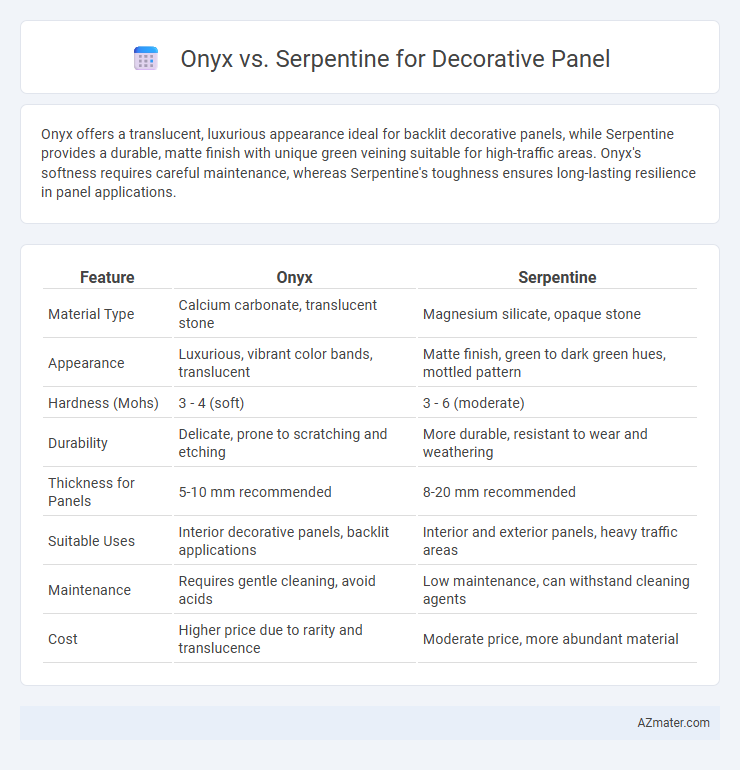Onyx offers a translucent, luxurious appearance ideal for backlit decorative panels, while Serpentine provides a durable, matte finish with unique green veining suitable for high-traffic areas. Onyx's softness requires careful maintenance, whereas Serpentine's toughness ensures long-lasting resilience in panel applications.
Table of Comparison
| Feature | Onyx | Serpentine |
|---|---|---|
| Material Type | Calcium carbonate, translucent stone | Magnesium silicate, opaque stone |
| Appearance | Luxurious, vibrant color bands, translucent | Matte finish, green to dark green hues, mottled pattern |
| Hardness (Mohs) | 3 - 4 (soft) | 3 - 6 (moderate) |
| Durability | Delicate, prone to scratching and etching | More durable, resistant to wear and weathering |
| Thickness for Panels | 5-10 mm recommended | 8-20 mm recommended |
| Suitable Uses | Interior decorative panels, backlit applications | Interior and exterior panels, heavy traffic areas |
| Maintenance | Requires gentle cleaning, avoid acids | Low maintenance, can withstand cleaning agents |
| Cost | Higher price due to rarity and translucence | Moderate price, more abundant material |
Introduction to Onyx and Serpentine
Onyx is a translucent, banded variety of calcite prized for its luxurious appearance and unique veining, making it a popular choice for high-end decorative panels. Serpentine is a durable, green-hued metamorphic rock known for its smooth texture and exceptional resistance to heat and moisture, often used in architectural applications. Both stones offer distinct aesthetic qualities and functional benefits, with onyx favored for its elegance and serpentine for its resilience in decorative panel installations.
Geological Origins and Composition
Onyx is a banded form of chalcedony, primarily composed of silicon dioxide with layers of quartz crystals formed through the slow deposition of silica in volcanic lava, resulting in its translucent and fine-grained texture. Serpentine originates from the alteration of ultramafic rocks rich in magnesium silicate minerals, featuring a typically greenish color due to its high content of magnesium and iron, and exhibiting a softer, more fibrous structure. Both stones showcase distinct geological origins and mineral compositions that influence their durability and aesthetic appeal in decorative panel applications.
Visual Appearance and Color Range
Onyx decorative panels feature a translucent, luxurious appearance with rich veining patterns that create a striking, high-end aesthetic. Serpentine panels offer a more opaque surface with a diverse color range, including deep greens, yellows, and golds, providing a natural, earthy elegance. The visual appeal of onyx emphasizes luminosity and intricate patterns, while serpentine highlights texture and a broader palette for versatile design applications.
Durability and Hardness Comparison
Onyx and Serpentine panels differ significantly in durability and hardness, with Onyx scoring around 3 to 4 on the Mohs hardness scale, making it softer and more prone to scratching and chipping. Serpentine, with a hardness of 5 to 6, offers greater resistance to wear, impact, and environmental factors, making it more suitable for high-traffic or exterior decorative panels. The superior toughness of Serpentine ensures longer-lasting performance in demanding applications, whereas Onyx is favored for its translucency and aesthetic appeal despite its lower durability.
Maintenance and Care Requirements
Onyx panels require careful maintenance due to their porous nature, needing regular sealing and gentle cleaning with pH-neutral products to prevent staining and scratches. Serpentine offers greater durability and easier care, resisting stains and scratches better while only requiring routine wiping with mild soap and water. Choosing serpentine reduces long-term upkeep costs and preserves the panel's aesthetic with minimal effort compared to the more delicate onyx surface.
Cost and Affordability Analysis
Onyx offers luxurious, translucent qualities that command higher prices, often ranging from $60 to $150 per square foot, making it a premium choice for decorative panels. Serpentine, being more abundant and less rare, is considerably more affordable with costs typically between $20 and $50 per square foot, providing cost-effective options without sacrificing aesthetic appeal. Budget-conscious projects benefit from serpentine's durability and lower price point, while onyx suits high-end applications where visual impact justifies the investment.
Design Versatility and Applications
Onyx offers exceptional translucency and unique veining, making it ideal for high-end decorative panels in luxury interiors, backlit features, and artistic wall installations. Serpentine provides greater durability and a wider range of green and earthy tones, suitable for both residential and commercial applications where strength and subtle elegance are required. Both materials enable diverse design possibilities, with Onyx excelling in creating dramatic visual effects and Serpentine offering robust performance in versatile paneling projects.
Environmental Impact and Sustainability
Onyx panels are typically formed from natural calcite, requiring energy-intensive quarrying and processing that contribute to higher carbon footprints compared to serpentine, which is a magnesium-rich silicate mineral often found in more abundant and accessible deposits. Serpentine's durability and resistance to weathering can extend the lifespan of decorative panels, reducing the need for frequent replacements and minimizing long-term waste. Both materials are recyclable, but serpentine's generally lower extraction impact and potential for using recycled content offer improved sustainability credentials for environmentally conscious architectural applications.
Popular Decorative Panel Projects
Onyx panels are prized for their translucent beauty and dramatic veining, making them a popular choice in luxury hotel lobbies and upscale restaurant interiors where light backlighting enhances their natural glow. Serpentine panels, known for their rich green hues and smooth texture, are favored in boutique retail spaces and high-end residential projects seeking a unique yet subtle statement. Both materials are selected for decorative panels due to their durability and distinct aesthetic qualities, significantly influencing modern architectural designs.
Choosing the Right Stone for Your Panels
Onyx offers a translucent quality and vibrant color patterns that make it ideal for illuminated decorative panels, adding elegance and luxury to interiors. Serpentine, known for its durable, dense composition and varied green hues, provides a more affordable yet visually appealing option for high-traffic areas. Selecting between onyx and serpentine depends on balancing the need for aesthetic impact and the panel's exposure to wear, ensuring longevity and design harmony in your space.

Infographic: Onyx vs Serpentine for Decorative Panel
 azmater.com
azmater.com